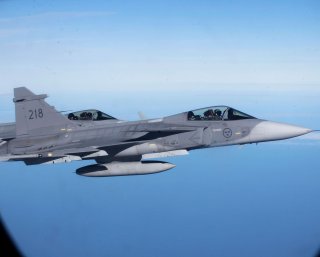Revealed: How the Swedish Air Force Would Fight World War III
The country would have made use of its Flygbassystem 90 system, which was designed to be unbeatable.
Here's What You Need To Remember: After the 1990s Cold War wind-down, much of the Flygbassystem 90 infrastructure was shuttered or sold, though interest in the basing system has enjoyed renewed interest in recent years.
Although Sweden does not share a border with Russia, the Scandinavian country is a mere 500 kilometers—or about 330 miles—from Kaliningrad, the Russian exclave on the Baltic Sea sandwiched between Poland and Lithuania. Kaliningrad, also Russia’s westernmost point, remains ice-free in winter and thanks to these two geographical features, the formerly German territory hosts the Russian Navy’s Baltic Fleet headquarters, as well as two air bases.
Though not a member of the North Atlantic Treaty Organization, non-aligned Sweden nonetheless feared an air attack from the Soviet Union during the Cold War. In an effort to preserve the Flygvapnet, or Air Force, in case of a conflict with the Soviet Union, Sweden developed a unique force dispersal concept called Flygbassystem 90, or ≈
Rather than concentrating aircraft and ground crews in small numbers of conventional air bases, Flygbassystem 90 called for both a wide dispersal of far-flung Swedish air forces around the country, coupled with a sprawling air base design and aircraft support infrastructure that would be more difficult to put out of commission in case of an air strike. Ultimately, Sweden wanted to have around 200 air bases spread out around the country.
Far and Wide
A single Bas 90 base was arranged in a triangular pattern, with three shorter runways making the points of the triangle, connected by public roads to a longer, central runway in the middle. This longer, central airstrip, typically about 2,000 meters, or about 6,500 feet long, would normally be surrounded by flight support infrastructure and considered the complex’s base and main landing area.
In case of strike on the base center, operations could quickly revert to the three shorter alternative runways. The Swedish Air Force incorporated the shorter runways into existing public highways by strengthening and in some cases widening roads sections to better support heavy aircraft taking off and landing. Points along the highway were also equipped with hardstands, reinforced concrete aprons that can support heavy planes for longer periods of time and prevent equipment from sinking into the ground.
Hardstands along the highway were camouflaged into the surrounding landscape and manned by ground crews. They also had communications connected to the main base, ready to refuel and rearm an airplane on the fly. Airplane decoys were also set up in the vicinity to draw fire from attacking Soviet airplanes.
Taken all together, a single Bas 90 base complex would be spread of a large area, and have several kilometers of usable flight strips and taxiways in total, creating a larger target area that was also more discreetly camouflaged into the road system.
Saab’s STOL Secret
The Bas 90 lynchpin was the Saab Viggen fighter, and at the end of the Cold War, the Grippen. Both single-engine fighter’s airframes benefit from a delta wing design with integrated canards. Together, these two design features give both airplanes good short takeoff and landing (STOL) characteristics and allow them to take off from very short runways. Both airframes are also prized for being maintenance-light, a boon to inexperienced, Cold War-era conscript air ground crews.
A More Modern Alterantive?
After the 1990s Cold War wind-down, much of the Flygbassystem 90 infrastructure was shuttered or sold, though interest in the basing system has enjoyed renewed interest in recent years. Russian revanchism has irritated the Scandinavian countries, and both the logic and utility of the unusual basing system seems relevant once again. Perhaps a more modern Flygbassystem 90 will be designed and built in the future.
Caleb Larson is a Defense Writer with The National Interest. He holds a Master of Public Policy and covers U.S. and Russian security, European defense issues, and German politics and culture.
This piece first appeared earlier and is being reprinted due to reader interest.
Image: Reuters

